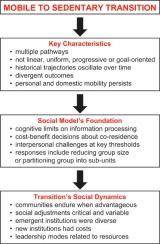Journal of Anthropological Archaeology ( IF 2.0 ) Pub Date : 2022-11-30 , DOI: 10.1016/j.jaa.2022.101468 Gary M. Feinman , Jill E. Neitzel

|
For more than 150 years, global perspectives on the mobile to sedentary transition have been framed by deeply entrenched categorical assumptions that have effectively blinded archaeologists to the fundamental importance of interpersonal relationships. Combining multi-disciplinary studies of living groups with recent archaeological findings, we formulate a model that identifies regularities and divergences in the social interactions and institutions of small-scale, variably settled communities. We then confirm the model’s diachronic validity for a sample of archaeological cases that followed alternative pathways to greater residential permanence. When interactive densities surpassed critical demographic thresholds and fissioning did not occur, diverse interpersonal realignments ensued. Much of the variability evident across cases stemmed from the characteristics of key resources. When resources were heritable, but not monopolizable, new institutional arrangements and social adjustments tended to be collectively organized, but when they were both, the new organizational arrangements tended to be more inequitable with greater power differentials.
中文翻译:

定居的社会动力
150 多年来,关于移动到久坐过渡的全球观点一直被根深蒂固的分类假设所框定,这些假设实际上使考古学家对人际关系的根本重要性视而不见。将对生活群体的多学科研究与最近的考古发现相结合,我们制定了一个模型,用于识别小规模、多变定居社区的社会互动和制度中的规律性和差异性。然后,我们确认该模型对考古案例样本的历时有效性,这些案例遵循替代途径以实现更大的居住永久性。当交互密度超过临界人口统计阈值并且没有发生裂变时,随之而来的是多样化的人际关系调整。许多个案之间明显的差异源于关键资源的特征。当资源可继承但不可独占时,新的制度安排和社会调整往往是集体组织的,但当两者兼而有之时,新的组织安排往往更加不公平,权力差异更大。











































 京公网安备 11010802027423号
京公网安备 11010802027423号